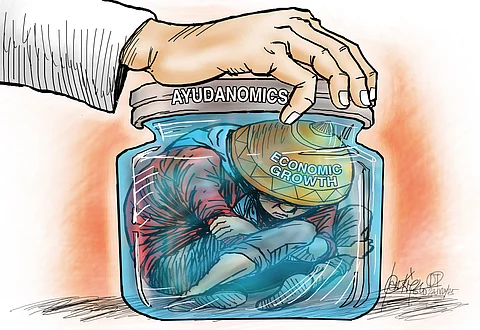
- NEWS
- the EDIT
- COMMENTARY
- BUSINESS
- LIFE
- SHOW
- ACTION
- GLOBAL GOALS
- SNAPS
- DYARYO TIRADA
- MORE

The economy, since the term of former President Gloria Macapagal Arroyo, has had an average growth rate of above six percent that now appears to be sliding, threatening the country’s goal of eradicating poverty.
The poverty rate of above 15 percent, or about 17.5 million Filipinos living below the subsistence line, is among the highest in the region in terms of the proportion of the indigent to the population.
According to World Bank (WB) estimates, the economy must grow at an average annual rate of seven percent to reach the goal of eradicating poverty and joining the ranks of high-income countries.
Without decisive reforms, the WB said the Philippines risks stagnating in a cycle of slow expansion and limited jobs quality.
The boom and bust cycle of the economy exhibits a pattern of growth surges during election years, followed by periods of slowdown.
The economic momentum is often interrupted, making it challenging to achieve the target of an annual growth rate of 6.8 percent which would create 5.1 million additional jobs and boost wages by 12.9 percent.
If the GDP growth rate of 6.8 percent is sustained until 2050, the WB estimates the economy could be brought “to the verge of a high-income threshold.”
The WB recently stated in a report that the Philippines remains a lower-middle-income country with a gross national income per capita of $4,470, or $26 shy of leveling up to upper-middle income.
Government spending and its priorities in the yearly budget play a huge role in the journey towards development.
Growth surges during an election year as the incumbent administration boosts public spending on infrastructure, social programs, and subsidies to gain votes for its allies.
Elections held every three years for national and local positions see massive private spending on rallies, advertisements, and vote-buying. Campaign budgets for national positions reach billions of pesos for each candidate, resulting in a surge in spending.
Short-term populist measures, such as the cash transfers or ayuda programs, are standard anti-poverty policies during these periods.
Prolonged reliance on ayuda may discourage labor market participation, which would be a tragedy for a nation in a demographic sweet spot where the majority of the population is of working age.
Even the Pantawid Pamilyang Pilipino Program (4Ps), the flagship initiative in the war against poverty, has been afflicted with leakages, corruption, and inefficiencies in targeting beneficiaries.
Commission on Audit reports highlight inclusion errors in 4Ps, where non-poor households that are well-connected to implementers receive aid.
What more the Walang Gutom program, Ayuda sa Kapos ang Kita program, Tulong Panghanapbuhay sa Ating Disadvantaged/Displaced Workers, and Assistance to Individuals in Crisis Situations, all of which are cash doles disguised as sectoral assistance programs.
The politically motivated doles prioritize short-term voter appeal over real poverty alleviation.
Since the measures are non-productive, fiscal tightening typically follows an election period, which reduces funding for development programs and thereby limits their impact.
While the 4Ps requires school attendance, quality education and vocational training are needed to prepare the children for employment.
Sustained infrastructure investment is also crucial for supporting economic diversification and propelling growth.
Progress translates to increased tax collection, which can fund broader social programs and reduce reliance on election-driven aid.
Prosperity can be attained only when the country’s leaders muster the will to cast away transactional politics.
